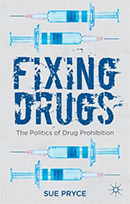Fixing Drugs: The Politics of Drug Prohibition

Author: Sue Pryce
Publisher: Houndsmills, Basingstoke, Hampshire; New York: Palgrave Macmillan. 2012. 173p.
Reviewer: Rashi K. Shukla | November 2012
The book Fixing Drugs: The Politics of Drug Prohibition provides a historically based critical examination of the drug problem from a global perspective. Through what may be perceived by some to be a viewpoint that is hypercritical of prohibition, Sue Pryce seeks to provide explanations for key questions that underlie current national and international drug policies. Such questions include, "Why is there a drug problem at all?" (p. 16), “How do states prohibit drugs?” (p. 49), and “What are the unintended consequences of prohibition?” (p. 83). Answers are embedded within a context richly supported with historical and comparative evidence. With the goal of providing clarity to vital questions that lie at the root of current drug policies that are supportive of the prohibition of some drugs but not others, this book provides a concise but detailed analysis that integrates historical evidence, global perspectives, and current events. The responses to questions posed throughout the book are crucial for placing an understanding of the current drug situation into a broader context.
The book is divided into eight chapters. Chapter 1 provides a brief introduction into the controversial nature of drug policy and the social desire for drug consumption. The significance of the disconnect between appeals for evidence-based policy and the continued, failing model of prohibition is described. Discussed as well are the challenges of obtaining accurate data on key indicators of the drug problem and the seductions offered by the consumption of drugs. In chapter 2, the focus is on providing an explanatory framework for understanding why certain drugs are classified as problems as opposed to others. With an introductory statement reminiscent of Orwell’s Animal Farm, Pryce states, “all drugs are a problem, but some drugs are more problematical than others” (p. 5). Using a method of presentation in which history is intertwined with modern controversies, the author provides readers with a comparative analysis of the diverse perspectives and uses for different categories of drugs in societies throughout history. Using the specific example of a comparison between tobacco and coca, the author describes the politics and rationales that underlie what are described as arbitrary classifications between substances that are classified as legal from those that are illegal. In explaining what is described as an often arbitrary line of legality, Pryce says that "the distinction between legal and illegal substances is derived from custom, convention and prejudice, reinforced by political ideology" (p. 12).
Chapter 3 presents an explanation for the question of why is there a drug problem at all. Here, the role of domestic policies supportive of prohibition, within a broader context of narco-diplomacy, used by powerful countries to persuade and promote bilateral and multinational prohibition is discussed.
Key historical events that shaped current drug policies, including early pieces of legislation supportive of a prohibition-based policy both within the U.S. and China, are briefly described. An explanation for prohibition that distinctly addresses ideological, economic, sociological, and political dimensions is provided. The multi-faceted explanation is valuable for addressing the diverse dimensions as being inter-related, yet distinct from one another. In chapter 4 the discussion turns to the mechanisms by which states prohibit drugs. Specific attention is given to the differences between supply-side policies such as crop eradication and interdiction, and demand-side policies such as education and treatment. The challenges of international eradication and interdiction efforts are described in a manner that is clear, yet concise. The chapter ends with a discussion of deterrence that specifically addresses the increasing incarceration rate in the U.S., as well as the so-called “the Hydra effect” (p. 80) that makes attempts to deter those involved in the profitable illicit drug trade through harsh punishments difficult, if not impossible.
Chapter 5 provides what is a thorough and insightful, yet often overlooked examination of the unintended consequences of drug prohibition. Following an explanatory structure similar to the one presented earlier, the unintended consequences of prohibition within ideological, economic, social, and political realms are described. The growth of illicit and untaxable markets, the criminalization of large numbers of the population, and the increase in corruption and political instability are discussed in detail. Once again, the explanations that are provided incorporate both historical and current evidence as supporting foundations. Chapter 6 addresses the question why persist with the failed policy (p. 114)? In what may be viewed as a controversial response, the oversimplification of solutions and current policies that are supported by ideological explanations, fear, expediency, bureaucratic inertia, and vested interests is discussed. Pryce’s explanation for this persistence is thought-provoking and will challenge readers to consider why alternative policy options often fail to be addressed in drug policy debates.
Chapter 7 seeks to answer the question is the attempt to prohibit drugs coming to an end (p. 126). Here, her focus is on the “increasing number of cracks” (p. 126) beginning to appear in international drug prohibition policy. At issue are the failure to reduce drug harm, ongoing high rates of consumption for cannabis and amphetamine type stimulants, and the growth of drug-related violence, corruption, and illegal markets. The author defines a number of key terms related to drug policy discussions including: harm reduction, decriminalization, depenalization, legalization, and regulation. She again weaves historical perspectives into current, modern controversies, sources of challenges, and calls for change in countries around the world including Britain, the Netherlands, Switzerland, and Mexico. The challenges inherent in achieving change are described in a manner that should be comprehendible to a novice reader. Signs of change occurring around the world, both in practice and rhetoric, are described. Alternative drug legalization models that could be used to replace prohibition are also briefly defined. These include: the medical prescription model or supervised venues, the specialist pharmacist retail model, licensed retailing, licensed premises for sale and consumption, and unlicensed sales (p. 142).
Finally, a rather brief concluding chapter reiterates the controversies and challenges inherent in current drug policies as well as options for change. The challenges inherent in changing policies are revisited. Pryce describes what she refers to as an “uncomfortable similarity” (p. 145) between those who remain committed proponents of prohibition and drug addicts. Consistent with the approach she uses throughout the book, Pryce concludes with a discussion that integrates a historical perspective with a modern one. She concludes with two insightful yet conflicting quotes. The first quote, from J. Hector St John Crevecoeur in 1782, describes regular drug consumption among women in Nantucket Puritan fishing communities (see pp. 149-15), briefly illustrating how normative drug use can be within the context of an otherwise functional lifestyle. The second quote, from James Brokenshire, the drug policy minister at the British home office, makes the point that decriminalization and legalization are too simplistic to address what is an otherwise complex drug problem. In conclusion, Sue Pryce argues that while opponents of change in drug policy argue that alternatives to prohibition are simplistic, “prohibition itself is a simplistic solution, which in practice has shown to be no solution at all” (p. 151).
Fixing Drugs is a thought-provoking and insightful book recommended for readers interested in developing an understanding of current drug policies in a broader historical context. The overall argument developed and supported here is unmistakably one that is opposed to prohibition. However, given that the arguments presented are grounded in historical and comparative evidence, this book is to be recommended for anyone with an interest in drug use and drug policy.
Rashi K. Shukla, Ph.D. , Associate Professor of Criminal Justice, University of Central Oklahoma


